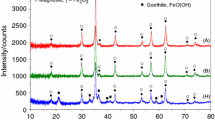Abstract
The 57Fe Mössbauer spectra of an iron-rich montmorillonite, an illite, and two glauconites were measured and computer-fitted with appropriate Fe3+ and Fe2+ doublet resonances. The broad experimental Fe3+ resonance of montmorillonite probably arises from Fe3+ in the octahedral sites and a trans-arrangement of OH groups; however, a large variation in the neighboring environment of these sites exists. In illite this Fe3+ resonance is similar but shows less broadening; it arises from Fe3+ located predominantly in trans-OH octahedral sites, with some Fe3+ being located in cis-OH octahedral sites. Because of the increased iron content less variation exists, compared with montmorillonite, in the neighboring octahedral sites. The Fe3+ resonance is narrower still for the glauconites and represents Fe3+ substituting primarily into cis-OH octahedral sites, similar to that previously reported for nontronite.
The tetrahedral Fe3+ content is very low for montmorillonite and increases progressively for illite and glauconite, suggesting that a higher tetrahedral Fe3+ content directs Fe3+ in the octahedral layer into cis-OH sites. In montmorillonite, the Fe2+ is located only in trans-OH sites; in illite Fe2+ is largely in trans-OH sites and only slightly in cis-OH sites; and in glauconite, Fe2+ is located largely in cis-OH sites and only slightly in trans-OH sites. These assignments suggest that for Fe2-, the doublet with the larger quadrupole interaction arises from Fe2+ in trans-OH sites and the doublet with the smaller quadrupole interaction, from Fe2+ in cis-OH sites.
Similar content being viewed by others
References
Besson, G., Bookin, A. S., Dainyak, L. G., Rautureau, M., Tsipursky, S. I., Tchoubar, C., and Drits, V. A. (1983) Use of diffraction and Mössbauer methods for the structural and crystallochemical characterisation of nontronites: J. Appl. Crystallogr. 6, 374–383.
Cardile, C. M. and Johnston, J. H. (1985) Structural studies of nontronites with different iron contents by 57Fe Mössbauer spectroscopy: Clays & Clay Minerals 33, 295–300.
Cardile, C. M. and Johnston, J. H. (1986) A 57Fe Mössbauer spectroscopic study of montmorillonites: A new interpretation: Clays & Clay Minerals 34, 307–313.
De Grave, E., Vandenbruwaene, J., and Elewaut, E. (1985) An 57Fe Mössbauer effect study on glauconites from different locations in Belgium and northern France: Clay Miner. 20, 171–179.
Drits, V. A., Plan? on, A., Sakharov, B. A., Besson, G., Tsipursky, S. I., and Tchoubar, C. (1984) Diffraction effect calculated for structural models of K-saturated montmorillonite containing different types of defects: Clay Miner. 19, 541–561.
Fanning, D. S. and Keramidas, V. Z. (1977) Illite and glauconite: in Minerals in Soil Environments, J. B. Dixon and S. B. Weed, eds., Soil Society of America, Madison, Wisconsin, 206–208.
Goodman, B. A. (1976) The effect of lattice substitutions on the derivation of quantitative site populations from the Mössbauer spectra of 2:1 layer lattice silicate: J. de Physique C6 37, 819–823.
Heller-Kallai, L. and Rozenson, I. (1981) The use of Mössbauer spectroscopy of iron in clay mineralogy: Phys. Chem. Minerals 7, 223–238.
Johnston, J. H. and Cardile, C. M. (1985) Iron sites in nontronite and the effect of interlayer cations from Mössbauer spectra: Clays & Clay Minerals 33, 21–30.
Kotlicki, A., Szczyrba, J., and Wiewiora, A. (1981) Mössbauer study of glauconites from Poland: Clay Miner. 16, 221–230.
McConchie, D. M., Ward, J. B., McCann, J. H., and Lewis, D. W. (1979) A Mössbauer investigation of glauconite and its geological significance: Clays & Clay Minerals 27, 339–348.
Mering, J. and Oberlin, A. (1967) Electron-optical study of smectites: in Clays and Clay Minerals, Proc. 15th Natl. Conf, Pittsburgh, Pennsylvania, 1966, S. W. Bailey, ed., Pergamon Press, New York, 3–25.
Rolf, R. M., Kimball, C. W., and Odom, I. E. (1977) Mössbauer characteristics of Cambrian glauconite, central U.S.A.: Clays & Clay Minerals 25, 131–137.
Ross, C. A. M. and Longworth, G. (1980) Mössbauer study of the attenuation of iron in an irrigated greensand lysimeter: Clays & Clay Minerals 28, 43–49.
Rozenson, I. and Heller-Kallai, L. (1977) Mössbauer spectra of dioctahedral smectites: Clays & Clay Minerals 25, 94–101.
Rozenson, I. and Heller-Kallai, L. (1978) Mössbauer spectra of glauconite reexamined: Clays & Clay Minerals 26, 173–175.
Tsipursky, S. I. and Drits, V. A. (1984) The distribution of octahedral cations in 2:1 layers of dioctahedral smectites studied by oblique-texture electron diffraction: Clay Miner. 19, 177–193.
Author information
Authors and Affiliations
Rights and permissions
About this article
Cite this article
Johnston, J.H., Cardile, C.M. Iron Substitution in Montmorillonite, Illite, and Glauconite by 57Fe Mössbauer Spectroscopy. Clays Clay Miner. 35, 170–176 (1987). https://doi.org/10.1346/CCMN.1987.0350302
Received:
Accepted:
Published:
Issue Date:
DOI: https://doi.org/10.1346/CCMN.1987.0350302




